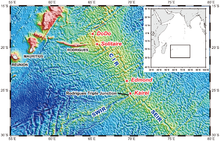|
Rimicaris kairei
Rimicaris kairei is a species of hydrothermal vent shrimp originally discovered in August 2000 with the ROV Kaiko on the R/V Kairei[1]. They are named for the R/V Kairei and the Kairei hydrothermal vent field on which they were first discovered.[2] They get energy from chemosynthetic symbiotic bacteria that live in their gut.[3] They reproduce sexually and have a larval stage in which they consume photosynthetic material.[4] Rimicaris kairei lives on four different hydrothermal vent sites on the Central Indian Ridge in the Indian Ocean.[2] They are the most populous invertebrate on these vents.[5] The species is differentiated from other species of Rimicaris Shrimp by a lack of setae, longer flagellar antennae, and less robust pereopods.[2]  DescriptionRimicaris kairei have entirely white bodies with blackened branchial chambers, possibly due to their symbiotic bacteria.[2] Their third to fifth pleopods have brown nails.[2] They do not have any eyes or eye stalks.[6] Rimicaris shrimp range from 4 to 5 cm long and generally weigh an average of 1.6 grams.[7] They have smaller pereopods than other species in the genus Rimicaris and lack setae that are present in Rimicaris exoculata[2]. Rimicaris kairei also exhibit longer flagellar antennae than their Atlantic counterparts.[2] Trophic relationshipsEnergy sourcesRimicaris kairei have symbiotic bacteria that undergo chemosynthesis. These symbiotic bacteria live in their intestines and manufacture energy by reducing sulfur from hydrothermal vents.[8] Adult Rimicaris kairei get their nutrition from their symbiotes through a direct transfer taking place on the cephalothorax.[3] Larval Rimicaris shrimp feed on photosynthetic organisms in the euphotic zone.[4] These shrimp will crowd as close to the hydrothermal vents as possible to get more food for their chemosynthetic bacteria. Along with being the most populous organisms in their vents they are the most dominant primary consumers.[5] One study found that there were 340 different species of symbiotic bacteria found in Rimicaris kairei individuals, but only 34 that made up more than 1% of the overall bacterial population.[8] Adult individuals have richer, more diverse populations of symbiotic bacteria which would allow them to better survive in their harsh environments. Importance in trophic websRimicaris kairei are the most dominant primary consumers in the Kairei vent field and Edmond vent field, making their symbiotic bacteria the most important primary producers at these hydrothermal vents.[5] They provide an important source of food for Marianactis anemones and Archinomid polychaete worms.[5] In fact Rimicaris kairei shrimp are the most important part of Marianctis anemone diets, which make up the second most populous group on the Kairei vents and most populous secondary consumer.[5] ReproductionRimicaris shrimp are protogynous and reproduce sexually through internal fertilization.[7] Rimicaris kairei shrimp reproduce during the austral summer, during the same time period as their Atlantic congeneric Rimicaris exoculata.[9] R. Kairei have lower fecundities than other shrimp in the Alvinocarididae family, and their egg sizes are larger than other species in the Alvinocarididae family.[9] This displays the tradeoff of using more energy to produce larger eggs while producing less offspring.[9] Rimicaris kairei shrimp undergo a larval stage where they consume dead photosynthetic organisms that fall through the water column.[4] This larval stage can be elongated and allows them to stray up to 100 meters from a hydrothermal vent.[4] This can explain how they are found in multiple different hydrothermal vent sites along the Central Indian Ridge.  DistributionRimicaris kairei live on hydrothermal vents in the Dodo, Solitaire, Edmond and Kairei vent fields located in the Indian Ocean along the Central Indian Ridge near the Rodrigues triple junction,[1] and are generally found at depths of 3000 to 3600 meters.[7] Rodrigues triple junction is characterized by active chimneys of the black smoker variety with similar chemical compositions to hydrothermal vents in both the Pacific Ocean and the Atlantic Ocean.[10] The Kairei and Edmond hydrothermal vent sites are characterized by high chlorinities and high concentrations of Iron Sulfide.[11] The Dodo and Solitaire hydrothermal vent sites are much closer to the central Indian Ridge spreading center than the Edmond and Kairei vents and have much different fluid chemical compositions.[12] Rimicaris kairei shrimp are present in high numbers and are often the most populous animal on the Edmond and Kairei vent fields, with their highest populations being seen at the Edmond hydrothermal vent system. These shrimp can often be seen crowding hydrothermal vent openings to get closer to their symbiotes' food source.[5] R. kairei shrimp are less populous on the Dodo and Solitaire vent fields, but they are still the most populous invertebrate found at these sites.[4] Populations of Rimicaris kairei shrimp have been found to be genetically identical in all of these vent fields, with data suggesting that larvae from the Edmond vent sites colonize the other three vent sites.[4] Shrimp in the Rimicaris genus were originally thought to have only lived in the Atlantic ocean before they were first discovered in the Kairei vent fields.[1] References
|
||||||||||||||||||||||||||||||
